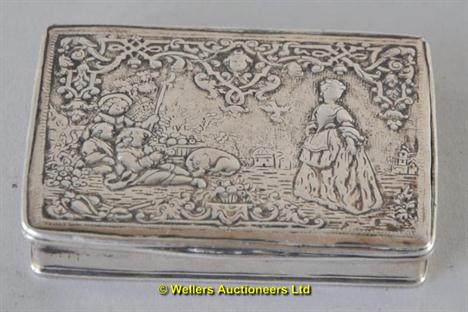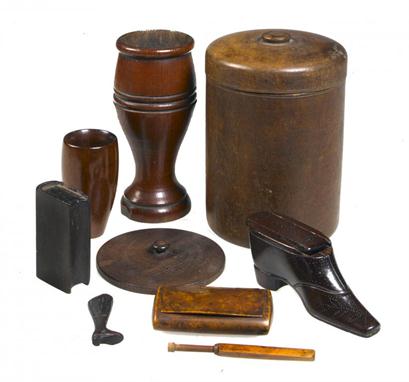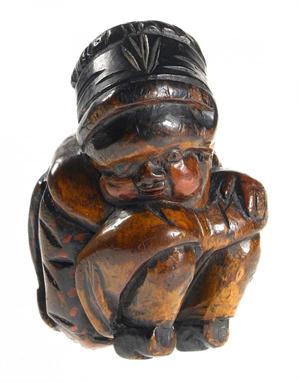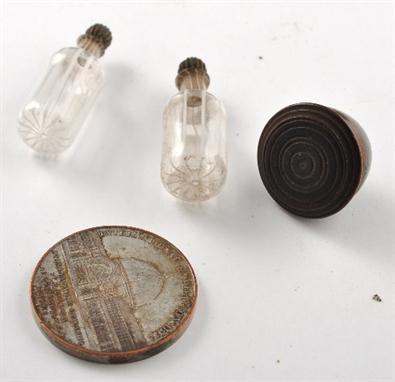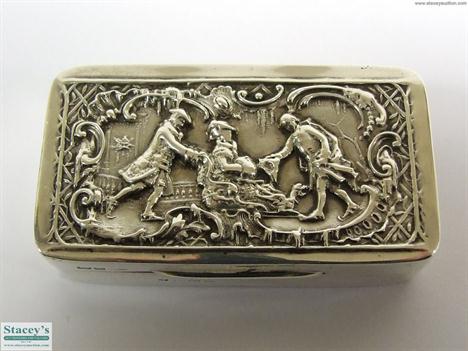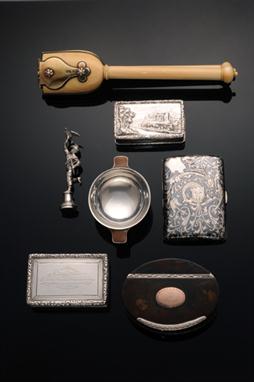We found 44471 price guide item(s) matching your search
There are 44471 lots that match your search criteria. Subscribe now to get instant access to the full price guide service.
Click here to subscribe- List
- Grid
-
44471 item(s)/page
A Continental three-colour gold oval snuff box, apparently unmarked, 19th century, the cover with a musical trophy within an arcaded floral border, the sides with ribbon-tied flowering foliage, the base with a port scene with ships, towers and a lighthouse, 7.5cm (3in) wide, 56.6g (tests between 14 and 18 carat)
A 19th century Continental gold cartouche shape snuff box, maker’s mark ‘CC’ over ‘S’ in a lozenge and an unidentified mark, the cover inset with an oval shell portrait cameo of a lady, on a matted ground with chased foliage and bossed, a scroll chased thumb piece, the sides and base foliate engraved, the interior in rose gold, 10cm (4in) wide, 199g gross
A French Louis XV two colour gold oblong snuff box, maker’s mark ‘PD’ with devices between and above, indistinct date letter, .916 standard discharge mark for Paris 1768-1774, with engine turned panels and lappet borders, the sides with swagged column dividers, 9cm (3.5in) long, 114.8g. A handwritten note inside reads ‘Gold snuffbox The property of Walter Spencer Stanhope MP said to have been a well known & popular snuffbox in the time of Wm Pitt’. This seems to refer to Walter Spencer-Stanhope (1749-1822), of Horsforth and Leeds, Yorkshire. He was a politician and industrialist whose family fortune had been made through the iron trade. He was a supporter of William Pitt the younger and of William Wilberforce.
A jewelled porcelain snuff box 2nd half 18th century, painted with a portrait between two putti, the base with a landscape and the sides with motifs of victory and war, four enamel patch or snuff boxes, variously decorated with figures, birds, flowers and sayings, and a porcelain box with hinged lid, printed in blue with an Oriental design, some losses, 8cm max. (6)
TOBACCO AND SMOKING. A GROUP OF TREEN REQUISITES including a pipe tamper carved in the form of a lady`s leg, 4.5cm h, possibly 18th c, an unusual tobacco pricker in the form of a cricket bat and another with turned handle, a Victorian mahogany snuff box in the form of a shoe decorated in brass pins, a burr maple snuff box with integral hinge, tortoiseshell lined, another in the form of a book, a finely patinated mahogany snuff mortar and a larger mortar of inverted baluster form and a turned oak tobacco jar and cover with inner cover (9) Comparative Literature: (pipe tamper) Pinto, plt 359, W1. ++Shoe snuff box with small old loss to the top, larger mortar with old flat chip on the edge of the foot, smaller mortar with minor natural old shrinkage crack, tobacco jar with repair to the cover
A VICTORIAN CARVED AND PAINTED FIGURAL SNUFF BOX crudely carved as a squatting plump woman with rosy cheeks, in a black bonnet and spotted dress, 7cm h ++Normal wear from use; the detachable lid in the figure`s back slightly damaged where prised open; the front of the feet with old damage, but unusual and in original condition
A collection of bijouterie, to include; a tortoiseshell ring box with turned bone feet, 6.7cm wide, a tortoiseshell snuff box with inset plaque, 6cm wide, a faceted ruby glass scent bottle 13cm long, and a ruby flashed scent bottle 12cm long (at fault) along with a silver medallion `Awarded for Excellence of Exhibit` at the `Midland Counties Trade Exhibition`, within J.A. Restall fitted case (5)
Misc. items, comprising chrome plated coin holder, sixpenny cylindrical banks (2), small silver plated purse with chain handle, amber cigar holder with gold plated inner & bezel, silver plated cigar holder with black mouthpiece, base metal vesta case with ornate flower pattern, circular compact style snuff box, chrome finished stamp book holder with Barmoral crest, miniature penknife, AA car badge with chrome finish & a Coronation 1937 souvenir tin by Rowentree`s (12)
A William IV silver castle top snuff box, by Joseph Willmore, Birmingham 1834, the hinged cover with an unusual view of Abbotsford within a leafy scroll border, the sides and base engine turned, engraved on a base with a crest with motto above within a rectangular shield, with inscription to the gilt interior, 7.75cm by 4.5cm, 3.8oz
Scottish School, 19th century ANDREW HUNTER, CAP` N. AYRSHIRE MILITIA 1810, BUST LENGTH Miniature on ivory 8cm high ebonised frame. See photo plate xi - `The Pedigree of Hunter of Abbotshill and Barjarg`, published 1905. Andrew Hunter of Bonnytoun and Doonholm, was born in 1776. He first went to sea from Greenock in the Countess of Haddingion, bound for the West Indies and America. In October, he was drafted to the Resistance (forty-four guns) and sailed in November for the Cape and East Indies, and while cruising off Mauritius captured a French fifty gun ship. In June 1794, while cruising in the Straits of Malacca, they seized a French twenty-gun ship, and Mr Hunter was sent as one of the officers in charge. In May 1803, his ship was captured by a French privateer, and he was landed at Analaboo, a Malay settlement, where he lived for six weeks, and in July was taken off by an American vessel and went to Muckee, where he heard of a Captain Petbury having been stabbed by the natives at Soosu and his ship in their possession. Mr Hunter then set off in an open boat to retake the ship, but was unfortunately blown off the shore and picked up by an American vessel, which succeeded in retaking the ship, and brought her to Sappanooly. During Mr Hunter`s next voyage, in July 1806, his vessel was captured by the French frigate, La Similliante (forty guns, Captain Motard), in September he was landed at the Isle of Bourbon, and in November taken to the Isle of France (now called Mauritius). After remaining in India for four months, he sailed for England, where he arrived in March 1808. In July 1808, he joined the Ayrshire Regiment as a Captain at Gosport, finally resigning in January 1810. Mr.Hunter was a Deputy-Lieutenant for the county of Ayr, and was gazetted Captain of the 2nd (or Cunningham and Cumnock) Ayrshire Yeomanry Cavalry on 28 June 1821. In 1814 he married Helen, eldest daughter of John Campbell, Esq., of Ormidale, Argyllshire. He died on 24 February 1876. See silver snuff box lot 537.
A George IV silver snuff box, by Thomas Shaw, Birmingham 1827, of engine turned rectangular form with foliate borders and reeded sides, the cover inscribed `Presented to Captain Hunter by the Cumnock Troop of Yeomanry Cavalry as a mark of esteem, 8th February 1828`, with gilt interior, 8.5cm by 5.5cm
-
44471 item(s)/page


















